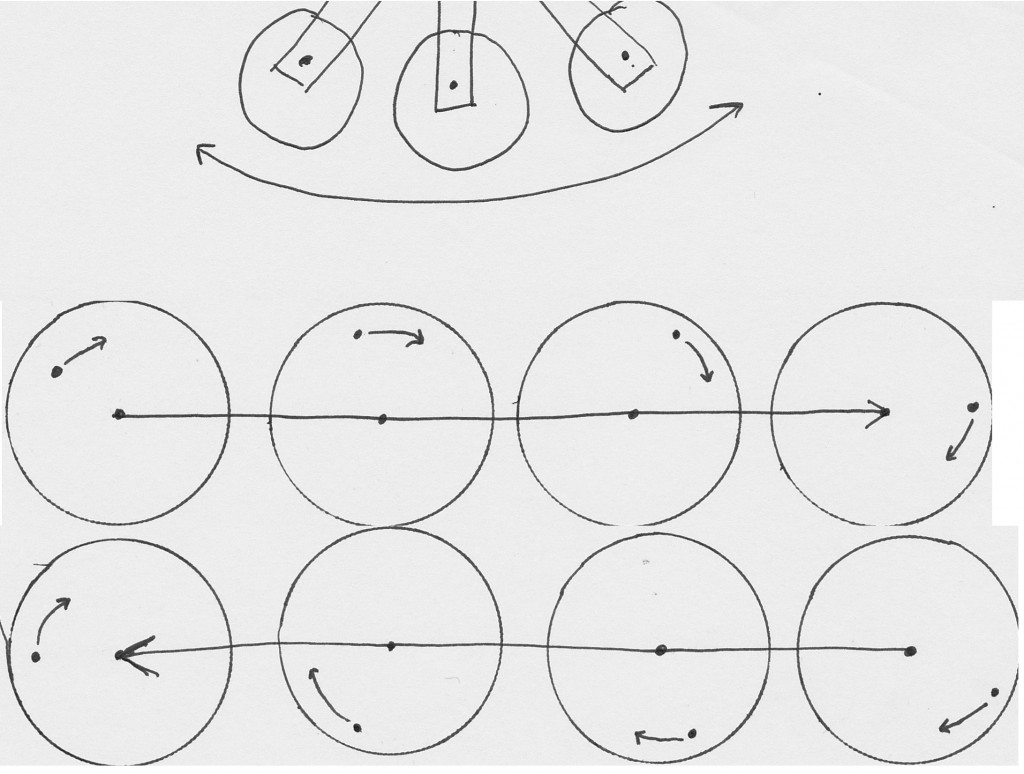You can get an elliptical motion with ONLY A LINEAR DRIVE. If there is any side to side movement allowed by the looseness of the connections, the ROTATING WEIGHTS will move it from side to side while the linear drive moves it back and forth. As long as the drive stroke is longer than the allowed side to side movement you will have an elliptical rotation. Perhaps THIS is what we are seeing in the video???
I have been working on a linear drive mechanism using a 18 volt saws all that is connected to two vertical shafts and I see this kind of elliptical movement in my build. The two vertical shafts are at the North South position, and both move away from center at the same time. In addition, I have figured out how to couple this to two more shafts in the East West position and these two shafts would move toward center at the same time as the North /South pair are moving AWAY from center. I wanted this alternating movement to keep the unit in some kind of balance so it will not rip itself apart, and this has been the TOTAL focus of my build. ALSO, two moving away and two moving in help to balance the force necessary to drive the system. I can also vary the length of the linear movement from the 2" available directly from the movement of the saws all, to as long a stroke as I want. Now that I have this part figured out, I am ready to go on to the the rest of the build. I have been working on THIS ONE PART of the build since this thread was first posted because I felt it was necessary to figure out how to move all FOUR vertical shafts with one linear movement, and I wanted two to go out while two moved in. Sometimes I just have to beat my head against the wall for a while before I can figure something out, and you all have moved way past me.
IF anyone is interested, I would be happy to share this, but you need to know I developed it as a LINEAR DRIVE and the ELLIPTICAL movement is more a result of the "looseness" of the design than anything I have designed on purpose. I felt like if I could get the linear movement in all the directions I needed, I could figure out how to modify it into an ellipse.
Aaron,
I share this because I believe working together is the ONLY way we can figure these things out, and I don't think we should overlook ANY possibility. I would hate to see anyone driven from this thread because of a difference of opinion. The proof is in the pudding. I think we all need to build according to our own opinion and see what we come up with. May the best man win.
Dave
I have been working on a linear drive mechanism using a 18 volt saws all that is connected to two vertical shafts and I see this kind of elliptical movement in my build. The two vertical shafts are at the North South position, and both move away from center at the same time. In addition, I have figured out how to couple this to two more shafts in the East West position and these two shafts would move toward center at the same time as the North /South pair are moving AWAY from center. I wanted this alternating movement to keep the unit in some kind of balance so it will not rip itself apart, and this has been the TOTAL focus of my build. ALSO, two moving away and two moving in help to balance the force necessary to drive the system. I can also vary the length of the linear movement from the 2" available directly from the movement of the saws all, to as long a stroke as I want. Now that I have this part figured out, I am ready to go on to the the rest of the build. I have been working on THIS ONE PART of the build since this thread was first posted because I felt it was necessary to figure out how to move all FOUR vertical shafts with one linear movement, and I wanted two to go out while two moved in. Sometimes I just have to beat my head against the wall for a while before I can figure something out, and you all have moved way past me.
IF anyone is interested, I would be happy to share this, but you need to know I developed it as a LINEAR DRIVE and the ELLIPTICAL movement is more a result of the "looseness" of the design than anything I have designed on purpose. I felt like if I could get the linear movement in all the directions I needed, I could figure out how to modify it into an ellipse.
Aaron,
I share this because I believe working together is the ONLY way we can figure these things out, and I don't think we should overlook ANY possibility. I would hate to see anyone driven from this thread because of a difference of opinion. The proof is in the pudding. I think we all need to build according to our own opinion and see what we come up with. May the best man win.
Dave




 That is his attempt to spin this out of context. Someone makes a claim - they should be equally open to justifying it. If they don't want to answer questions, then they have a double standard.
That is his attempt to spin this out of context. Someone makes a claim - they should be equally open to justifying it. If they don't want to answer questions, then they have a double standard.


Comment